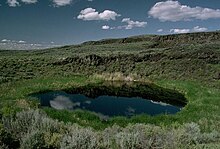Harney Basin
| Harney Basin | |
|---|---|
 Harney Basin near Burns, Oregon | |
 The Harney Basin (dashed yellow perimeter) | |
| Floor elevation | 4,111 ft (1,253 m)[1][2] |
| Area | 3,855 km2 (1,488 sq mi) |
| Geography | |
| Coordinates | 43°15′14″N 118°42′54″W / 43.25389°N 118.71500°W |
| River | Donner und Blitzen River; Silvies River |
| Lake | Harney Lake; Malheur Lake |
The Harney Basin is an endorheic basin in southeastern Oregon in the United States at the northwestern corner of the Great Basin. One of the least populated areas of the contiguous United States, it is located largely in northern Harney County, bounded on the north and east by the Columbia Plateau—within which it is contained, physiographically speaking—and on the south and west by a volcanic plain. The basin encompasses an area of 1,490 square miles (3,859 km2) in the watershed of Malheur Lake and Harney Lake. Malheur Lake is a freshwater lake, while Harney Lake is saline-alkaline.[3]
The basin is bounded on the north by the southern end of the Blue Mountains. The ridge of Steens Mountain separates the basin from the watershed of the Alvord Desert to the southeast.[4] No streams cross the volcanic plains that separate the basin from the watershed of the Klamath River to the southwest. The basin includes archeological sites of the Drewsey Resource Area.[5]
Geography

The central basin receives an average of 6 inches (150 mm) of rain per year, with the surrounding mountains receiving an average of 15 inches (380 mm) per year.[
Harney Basin Volcanic Field
The Harney Basin Volcanic Field is a series of volcanic flows of rhyolite and of tuffs of ash flows in around Burns, Oregon.[7] The field is within the High Lava Plains Province.[8]
Harney-Malheur Lakes watershed
The Harney-Malheur Lakes watershed is a 1,420 sq mi (3,700 km2)[9] Great Basin watershed.[10] The adjacent Donner und Blitzen River watershed of 765 sq mi (1,980 km2) discharges into Malheur Lake and includes the river portion of the 292 sq mi (760 km2) Malheur National Wildlife Refuge. "Alkali Field is located directly south of Malheur Lake, a few kilometers east of the Donner und Blitzen River."[11]: 23
The
History

The basin was formed approximately 32,000 years ago when
In the 19th century, the basin was inhabited by the
Because of its climate, it received sparse white settlements and was largely left to the Paiute until the late 19th century. Settlement pressures and conflicts with the Paiute in other areas of Oregon caused President
The basin has a widespread decline in groundwater which has put the region at risk of ecological and economic collapse. Irrigation pumping is dropping the water table as much as 10 feet (3.0 m) every year in one area.[14]
See also
References
- ^ "Query Form For The United States And Its Territories". U.S. Board on Geographic Names. Retrieved 2010-05-13.
- ^ "Harney Basin (1132071)". Geographic Names Information System. United States Geological Survey, United States Department of the Interior. Retrieved 2010-05-26. Harney Valley (1132040, also a basin), Malheur Gap (1123708)
- ^ GREATER HARNEY BASIN AGRICULTURAL WATER QUALITY MANAGEMENT AREA PLAN Archived 2008-06-26 at the Wayback Machine (pdf), p. 15 & p. 17ff.
- ^ Google Earth: bbs.keyhole.com/ubb/placemarks/cl-03-20-06-980475833.kmz
- ^ "Harney County Oregon, Range Seeding Projects". Archaeology: Harney County, Oregon. Archived from the original on 2011-01-03. Retrieved 2010-12-25.
- ^ "2010 Demographic Profile Data: Harney County, Oregon". U.S. Census Bureau. Archived from the original on 2020-02-13. Retrieved 2015-03-21.
- ^ "Stratigraphy Theme Key". Oregon Geologic Data Compilation. Oregon Department of Geology and Mineral Industries. Archived from the original on 2010-11-27. Retrieved 2010-12-26.
- ^ Michael L. Cummings, Sherry L. Cady, and Robert B. Perkins, A tale of two basins: Comparisons and contrasts in the high desert hydrogeology of Steens Mountain, southeastern Oregon, Geological Society of America, Field Guides, 2009, 15, p. 295-318, doi:10.1130/2009.fld015(15)
- ^ "Boundary Descriptions and Names of Regions, Subregions, Accounting Units and Cataloging Units". USGS.gov. Retrieved 2010-05-26.
- Environmental Protection Agency. Retrieved 2010-05-07.
- ^ "Harney County Oregon, Range Seeding Projects". Archaeological Report. AJMorris.com. Archived from the original (p. 23) on 2010-09-17. Retrieved 2010-05-26.
Texaco Basin was surveyed by Thomas, Goheen and Loring on August 13, 19 and 20, 1980 [p. 19]
- ^ See Robert S. Thompson, et al., "Climatic changes in the western United States since 18,000 yr B.P." in Herbert Edgar Wright, et al. eds. Global Climates Since the Last Glacial Maximum 1993.
- ^ Nancy Langston, William Cronon, Where Land & Water Meet: A Western Landscape Transformed 2006:135 and note 66.
- ^ Cook, Emily Cureton (March 16, 2022). "Race to the bottom: How big business took over Oregon's first protected aquifer". Oregon Public Broadcasting. Retrieved 2022-03-16.
